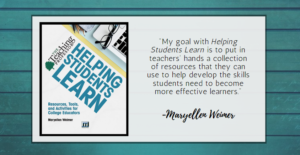
Music in the Classroom
As faculty, we want our students to achieve, but more than that we want our students to see, at least in some way, that what

As faculty, we want our students to achieve, but more than that we want our students to see, at least in some way, that what

To: My Students From: Your Teacher Re: What’s happening in college—is it real? I just read about a senior engineering student who was presenting a

This week on The Focus is You, we’re getting to know Angela Britcher who works in instructional design, faculty training, and content writing. We’ve catered

This article is featured in the resource guide, Effective Online Teaching Strategies. Prior to every course, faculty should consider how they can connect with their

A common practice at many colleges and universities involves course faculty inviting librarians into their classrooms to teach research and information literacy skills and concepts

Our “office hours off campus” idea transpired from a speech given by Dr. Iain Campbell at a publisher’s workshop we attended. Dr. Campbell teaches large

In this week’s, The Focus is You, we chatted with Adam Arenson, PhD, associate professor of History at Manhattan College and director of the Urban

With over a decade in training and management of college teachers, I saw late policies ranging from “not one second late, period” to “any time

As faculty members prepare to start their classes and courses for the 2019 school year, it’s important to remember that not all students attending college

This article is featured in the resource guide, Effective Online Teaching Strategies. Inclusive practices are critical to the higher education landscape in order to improve
Get exclusive access to programs, reports, podcast episodes, articles, and more!